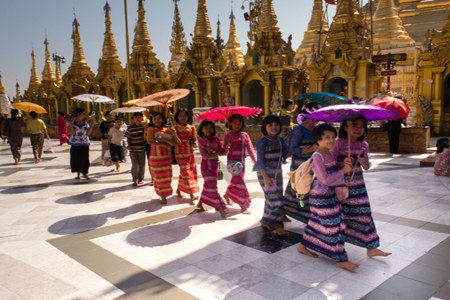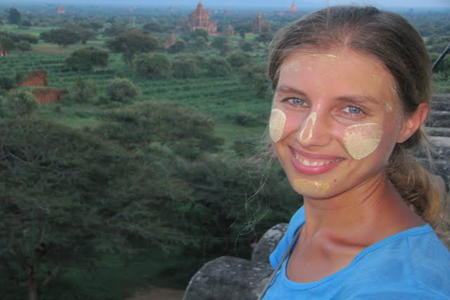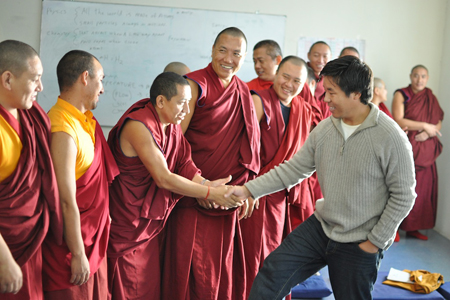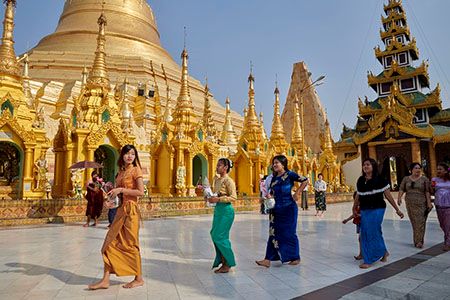The Burmese people are religious people and hold all persons, places or things associated with religion in much veneration. This is true of Buddhists as well as Christians. Since your Myanmar tour will take you to many places that Buddhist and Christian it is necessary to be informed of modes of dress and behavior which might cause displeasure or surprise and so should be avoided. On the other hand, there is much appreciated when a foreign person is seen to be observing the proper form.
Remove footwear before entering pagoda precincts
Footwear must be removed before entering the pagoda grounds. In some places, in some countries, footwear may be permitted up to the building in which the Buddha image is enshrined, footwear is removed only when the shrine building is entered. In Myanmar, it is considered essential to remove footwear before entering the compound in which the pagoda or shrine is sited.
The question of footwear in pagoda precincts was a crunch issue during the colonial period. There was uproar in the country when the British rulers claimed the right to wear shoes in pagoda precincts and an armed rebellion almost ensued. The shoe question gave impetus to Myanmar's struggle for independence and was the beginning of the end for British colonial rule.
Another question: "After shedding the shoes, should one keep the socks on?" The short answer: What you wear on the foot is footwear. Right? It is more comfortable to be barefoot in those places. And you don't want to start a war, do you?

Remove footwear before entering monastery precincts
The same rule of removing footwear applies before entering monastery precincts. But in some cases, there can be a relaxation of the rule. The presiding monk, with the consent of the resident monks, may permit footwear in the monastery precincts. An example is the Hermitage of MahaSi in Yangon where footwear is permitted. The grounds of the Hermitage are extensive and many foreigners come to meditate or to visit. However, there are many more monasteries where the rule is followed.
How do you know what to do? Observe others. If the locals keep their footwear on, you may do so. If you meet no one, it is better to remove the footwear until someone tells you that you may have them on.
Monks and novices remove their footwear when on their morning rounds to accept merit food.
Wear decent clothes to the pagoda or monastery
Don't go dressed to the pagoda or monastery as you would to the beach in a loose blouse, semi see-thought or short shorts. The rule against short pants, apply to men too. Pagodas and monasteries are centers of Buddhist veneration, and Buddhism teaches that the cause of all suffering is desire. In this instance, though the dress may not be an embarrassment to oneself, it is better not to be an embarrassment to others. Wear decent clothes when going to the pagoda or monastery.
Behave in a proper manner
The pagoda or temple is a place of worship and spiritual development, and as such is worthy of proper behavior. Avoid rowdiness, shouting or laughing and making fun. At the Shwedagon Pagoda in Yangon, music is not permitted on the Pagoda platform. Music troupes who usually accompany novice-to-be processions to the Pagoda leave their instruments at the foot of the 326 feet (99.4 meters) Pagoda Hill. Some monasteries do not permit music on their grounds; some do. Pagoda festivals have theaters and music halls built on sites set aside for them.

Avoid being a nuisance when taking photographs
Some pagodas and temples such as the Shwedagon Pagoda at Yangon and the temples in the archaeological zone at Bagan require the payment of a fee to take photographs. A few such as the Myinkaba Gupyauk-Kyi at Bagan do not permit photography altogether in order not to affect the murals. So don't take photographs if not allowed.
Avoid lewd or funny postures with pagodas or Buddha images as a background. Don't lean on Buddha images or otherwise use them as props. Monks do not like to be photographed. No show of annoyance on his part only means that he is forbearing. It is proper to ask permission first.
Don't sit with back against Buddha image
You may have occasion to sit or rest in a prayer pavilion or shrine which houses a Buddha image or images. Or you may form a conversation circle with your companions in these places. If you do so, don't sit with your back against a Buddha image. It is obviously a sign of disrespect or ill-manners.
Even if you are outside the prayer pavilion you may still be on the pagoda terrace or platform. At the Shwedagon Pagoda in Yangon, you would be on the platform with the Pagoda looming over you. If you sit on the platform it is better not to sit with the Pagoda at your back.
Tuck away your feet
When you sit on the floor, as you will do, in a prayer pavilion, on the pagoda platform or in a monastery building do sit neatly or modestly. The legs should not be stretched out. The feet should be tucked away, the skirt pulled over the knees. It is better if the tucked away feet are not toward the Buddha image or pagoda.
Don't show sexual affections at the pagoda
It should be clear without prompting or reminding that a pagoda, temple or monastery is a place of worship or reverence and that indulgence in or exhibition of sexual affection is not proper there. Show of sexual affection is hugging, teasing or kissing. The simple holding of hands might pass but why do even that when there are other occasions and places to do it.
Don't disturb people praying or meditating
People praying or meditating can be disturbed by loud talk, laughter or movements beside them. Avoid loud talk or laughter near those people. When going up to a Buddha image or a planetary prayer post or passing through a prayer pavilion, take care not to step on or brush against them, especially when the prayer pavilion or terrace is crowded.
Don't handle Buddha images or sacred objects with disrespect.
You may forget that Buddha images or statuettes are sacred, and willy-nilly leave them on the floor, at the foot of the bed, or more seriously, throw them among the shoes. You may even wrap them with women's underwear to pack them in the bag. Avoid doing these. The same advice goes for statuettes of gods, photographs of pagodas, Buddha images or monasteries and books with pagodas on the cover. Do not take such books to read in the bathroom or leave them there.
Don't keep Buddha images or sacred objects in inappropriate places
Keep Buddha images, statuettes of arahants or gods, photographs of pagodas and books with pagodas on the cover or books on Buddhism on tables or desks at the head-end of the bed, not at the foot-end of the room nor in the bathroom. Back home do not place them at the foot of the stairs or even on a table in the hall or lobby if the flight of stairs goes over them. Don't keep them on the floor in the parlor or drawing-room; put them at least on a table or pedestal.
Leave a donation
You will find little glass cases with a slit opening on top and money inside or booths accepting donations for upkeep, illumination, gilding, of the pagoda and for the nine functions. It is not essential that you do it but you will feel good to leave a small donation. If you donate to the booth, you will get a receipt.
Show respect to monks, novices and nuns
A monk observes the 227 rules of the Discipline, studies the Doctrine, practices meditation, is celibate, does not eat after noon, leads a life of abstinence and minimum wants. He is worthy of respect and reverence. The young boy in yellow robes observes much fewer rules but the discipline is equally strict. He is dedicated to becoming a monk and is waiting to reach the permissible age of ordination. He is equally worthy of respect. The female religious person in light-yellow robes and the clean-shaven head is a nun who is equally dedicated to a life of discipline and the study and practice of the Doctrine. She is only a nun because the lineage has been broken and there is now no Order of Bikkhuni (female monks).
Don't offer to shake hands with a monk
However friendly you may feel and however cordial he may appear to be, don't offer to shake hands with a monk. That would be disrespectful. You can raise your hands with palms pressed together in a gesture of reverence. This is the action of gadaw. about which earlier.

Offer articles with both hands
When offering a gift to a monk, do so with both hands. Whether standing or sitting you should approach him to within comfortable reach of your extended hands so that he does not have to bend forward. If the presentation is not within comfortable reach, the act of giving is not accomplished and he will give away the article.
Sit lower than a monk
Don't sit higher than or at a level with a monk. Place him on a chair or platform so that you will be at a lower level. If there is no platform or chair available, he will sit on a thin cloth cushion that is laid out. By this means, he raises himself that much from the floor on which you sit directly and saves you the act of disrespect.
What to do when offering a money donation
A monk is not allowed to handle money. But in an economy where virtually everything is monetized, it is impossible to live without money. The monastery needs money for upkeep, repair, and development, for the feeding of monks and novices, and for the "nine functions". If you wish to help by donating money, you should put the money in an envelope or a fold of paper and request the monk to designate a layperson to accept the donation. When he does so you can hand over the money to that person. The money will be entered into an account held in trust, and used for the "nine functions". The monk may ask for donations to be paid out of that fund to other monasteries, pagodas or charities.
Don't offer food afternoon
The rules of the Discipline does not permit a monk to eat after twelve o'clock noon. A novice and a nun also abstain from eating after that time. However, they may accept a drink of lemon juice or other fruit juice free of pulp or substance. They will not take milk or tea or coffee. The next food accepted will be the earliest at dawn.
Don't stamp on a monk's shadow
If you meet or overtake a monk whose shadow is cast towards you, step aside, not only to avoid brushing up against him but also to avoid stepping on his shadow. A monk's shadow is as much a part of him and to step on it, especially the shadow of the head, is a sure sign of disrespect.
A woman should not touch a monk
The rules of the Discipline does not permit a monk to touch anything female, let alone a woman. To be touched by a woman is an infraction of the rule. Also, it is disrespectful on the part of the woman. To let him avoid the consequence of breaking a rule and also as a matter of respect, a woman should not touch a monk. She should avoid the possibility in a crowd or conveyance for the monk to be pushed to brush up against her by moving aside. Myanmar women follow this behavior.


